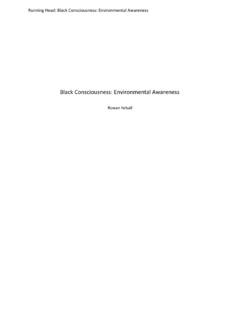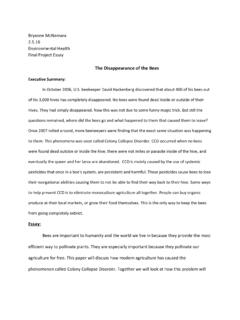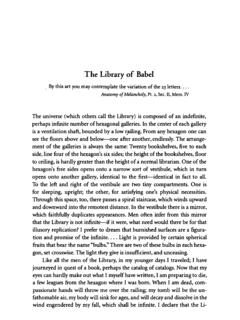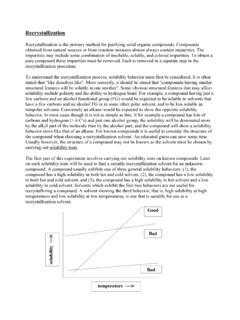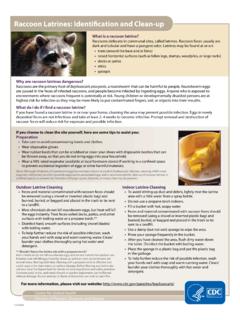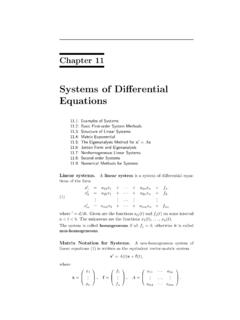Transcription of Chemistry Lab 1: Density of Aqueous Sodium Chloride …
1 Chemistry Counts! Spring 2016. Chemistry Lab 1: Density of Aqueous Sodium Chloride Solutions Adapted from Ross S. Nord and Stephen Schullery, Eastern Michigan University OVERVIEW. The goal of this lab is to determine the Density of an unknown Sodium Chloride solution by measuring its mass and volume and comparing with a standard curve prepared from solutions of known Density . You will learn how to create and use a standard curve and practice using pipets, graduated cylinders, and balances. Density AND MASS PERCENT. The Density of a liquid is usually directly related to the solution's concentration. Because the Density of a liquid is easy to measure, this provides a convenient method of determining the concentration.
2 =.. For a liquid, the volume is readily determined using accurately graduated glassware such as pipets, burets, or volumetric flasks. Since the volume of a substance varies with temperature, it is important to record the temperature of Density measurements. When comparing the densities of different samples, the temperature should be held constant for all the volume and mass measurements. The concentration of an Aqueous solution can be expressed in many different ways, but the simplest is mass percent (also called weight percent): . % = 100. + 2 . STANDARD CURVES. The Density of Aqueous NaCl solutions is a nearly-linear function of the NaCl concentration (in mass percent).
3 A linear relationship permits a reliable standard curve to be constructed (see Figure 1). A standard curve relates some measurable property (such as Density ) to the concentration and is an essential feature of any quantitative chemical analysis. Figure 1. Density vs. mass % NaCl. The best-fit line was added using linear regression. PRE-LAB QUESTIONS. Answer these questions on a separate sheet of paper after carefully reading the lab procedure. 1. Some of the words in this lab may be new to you. Make a list of any new vocabulary and their definitions. 2. What is a standard curve? What can we determine using the standard curve we make in this lab?
4 3. How many mass measurements will you make during this lab? 4. Look up the materials safety data sheet (MSDS) for Sodium Chloride . What are the hazard ratings for health, flammability, and reactivity? The scale for these ratings is 0 4. Look up Hazardous Materials Identification System (HMIS) and describe this scale. EXPERIMENTAL SECTION. You will work with a partner to create the standard curve but otherwise you need to make all your own measurements. CLEAN UP NOTES. All solutions in this lab can be disposed of down the drain. Clean up any chemical or liquid spilled in the Balance area. Rinse your glassware with distilled water and dry it when finished.
5 Part I Determine the Density of water at room temperature Fill a 50 or 100 mL beaker with approx. 50 mL of DI water from the large carboys. Rinse a 10 mL pipet with a small quantity of DI water. Tare an empty 50 or 100 mL beaker and then remove the beaker from the balance. Use the pipet to add a mL aliquot of DI water to the beaker. Place the beaker back on the balance and record the mass of the water. Repeat 2 more times for a total of 3 mass and volume measurements. Check your technique by making sure your three trials are very similar to each other and close to 10 g. Part II Make a standard curve There are 5 standard solutions to prepare with your partner.
6 You may split up the duties so that one of you makes 2. solutions and the other makes 3. Create a table in your notebook for your data: Solution # Beaker mass (g) Beaker + salt (g) Beaker + salt + Calculated Calculated water (g) Salt mass(g) Water mass (g). 1. Weigh out the mass of NaCl for your first standard solution (see Table 1). Place a clean, dry, 50 mL (or 100 mL) beaker or 50 mL Erlenmeyer flask on a balance and then use a spatula to add solid NaCl to the flask. The mass of solid does not need to be exactly the mass given in the table. But you do need to know exactly how much you measured out, so record the mass to the g place. Do not spill any salt on the balance.
7 The NaCl can corrode the balance, ultimately ruining it. CLEAN UP any salt that you spill. Additionally, salt spilled on the balance pan will affect the weight and change your results (for the worse). For these reasons it is generally considered to be a bad idea to add any chemicals to a flask while it is sitting on a balance. It is better to remove the flask, add the chemicals, and replace the flask on the balance. Table 1. Approximate masses of NaCl to use. **Record actual mass used to g decimal place**. Solution Number Mass of NaCl (g). 1 6. 2 3 3. 4 2. 5 1. 2. Find the mass of beaker + salt. Remove the flask from the balance. Then add approximately 30 mL of DI water to the flask and find the mass of beaker + salt + water.
8 Use a graduated cylinder to roughly measure the amount of liquid. Again, record the mass to the nearest g. 3. Thoroughly mix the solution by swirling or stirring with a glass stirring rod until all of the solid has dissolved. 4. Measure and record the temperature of the solution (to the nearest C). All five standard solutions must have the same temperature (+/- 1 C). The temperature of a solution can be adjusted by holding the flask under hot or cold running water (being careful not to splash any water into the flask). Whenever reading calibrated glassware, always try to estimate one decimal place beyond the closest calibration marks. 5. Measure the mass of a mL aliquot (sample or portion) of the standard solution.
9 Rinse a 10 mL pipet with a small quantity of the solution to be measured. Find the mass of an empty and dry 50 or 100. mL beaker and then remove the beaker from the balance. Use the pipet to add a mL aliquot of the standard solution to the beaker. Place the beaker back on the balance and record the mass of the solution + beaker. The mass of each aliquot (10 mL of salt water) should have a mass somewhere between 10 and 12 g. Create another table for this data. 6. Thoroughly clean and dry your beakers before starter the next standard solution. Repeat the above steps for the remaining standard solutions. For each solution, weigh out a mass of NaCl close to the amount in Table 1.
10 Part III Determine the concentration of an unknown NaCl solution Each person must do their own unknown. 1. Fill a dry 50 or 100 mL beaker with approx. 50 mL of your assigned unknown solution. Record your unknown number on your data sheet. 2. Measure the temperature of the unknown. It should be within 1 C of the standard solutions measured earlier. 3. Measure the mass of a mL aliquot of the unknown using the procedure described in step 5 above. Repeat two more times. CLEAN UP ANY CHEMICAL OR LIQUID SPILLED AROUND THE BALANCES. RINSE YOUR GLASSWARE WITH DI WATER AND DRY IT WHEN FINISHED. Continue with the Post Lab Workshop below whenever you finish the lab.
